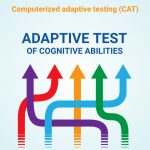COGNITIVE TESTS
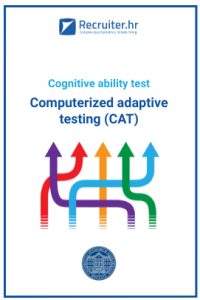
ADAPTIVE COGNITIVE ABILITY TEST (CAT)
This adaptive test represents a more sophisticated method of measuring general intelligence. It is based on the idea of adapting the test to each individual. The construction and validation of the first Croatian adaptive test was encouraged by technological advancements in general, and the challenges of a modern organizational environment. It was carried out as part of a carefully designed project, in cooperation with professors from the Department of Psychology of the Faculty of Philosophy, University of Zagreb; with the aim that the final test result provides quick, simple, and precise information about the level of development of a person’s general cognitive ability. The test relies on three different types of tasks. The stimulus material it includes requires the examinee to continue a certain sequence, complete the matrix or kick out the intruders, based on abstract thinking and logical reasoning. In practice, it means displaying only the most appropriate tasks for each person solving it. A complex algorithm in the background selects the tasks that provide the most information in an effort to assess and describe an individual. In numerous evaluation situations, it has shown its value, simplicity and practicality, often providing precisely the key and necessary information.
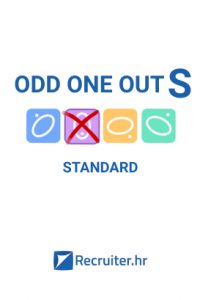
ODD ONE OUT S
The “ODD ONE OUT S” test measures cognitive abilities of individuals. It was developed in response to the needs of organizational psychologists for an instrument that, in the context of selection assessments for employment, would quickly and easily describe the general cognitive capacities of candidates. The test consists of a series of original tasks. In order to solve them successfully, logical reasoning is necessary. Basically, the test contains photos among which the intruder needs to be found. In other words, among the four offered images, the person who solves the test should remove one, which, logically, is significantly different from the others in some way. That underlying logic of kicking out the intruders often implies the ability to perform mental rotations. People who achieve high results on this test do well in situations where they need to connect and conclude something quickly, they understand spatial relationships and, as a rule, they have no problems understanding what is being asked of them. On the other hand, people who achieve low results on this test are generally not suited to extremely complex, responsible, and dynamic jobs because they usually need a bit more time to learn new things.
As part of the validation of this instrument, good psychometric characteristics were determined on large samples of respondents, which confirmed its quality. It has also shown its value and usability in a huge number of selection situations in which it has been involved in so far.

ODD ONE OUT A
The test “ODD ONE OUT A” basically measures the same construct as the “Eject Intruder S” test, in the same way, but with slightly more demanding stimulus material. It is precisely for this reason that it is intended for somewhat already selected samples of candidates, for instance, people applying for high positions in organizations. The letter A in its name indicates the so-called Advanced version, unlike the standard – S version.
Namely, the construction of cognitive tests in the first step requires a large number of potential tasks which, based on statistical analyses, are retained, eliminated or revised. In addition to the standard form of the test, which emerged as a result of multiple preliminary analyses and working versions, a part of the designed tasks was grouped into a completely new set representing a more difficult version of the instrument. Therefore, “ODD ONE OUT A” is more suitable for individuals with more developed cognitive abilities, highly educated staff and in general candidates who apply for higher positions or show an interest in working on more complex content or in more demanding circumstances. Based on the results of this test, it is possible to identify people who easily apply logical reasoning, who succeed without problems in mental rotation and visualization of characters, and who simply understand the various principles on the basis of which some elements can be connected and/or differentiated.
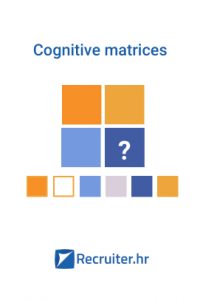
COGNITIVE MATRICES
The cognitive matrices test was developed within the organizational context as a measure that provides psychologists with extremely valuable information about the level of development of the general intelligence of individuals. It includes tasks that reflect a person’s ability to see, perceive and discover relationships and generally cope with solving new problems. As its name suggests, it consists of matrices, and the participants are asked to complete them logically, in order to get a complete picture. In selection situations and various organizational assessments, it has proven to be useful because, with its excellent psychometric characteristics, quality and ease of use, it is an instrument that greatly facilitates the assessment of individuals by positioning them at a certain level, depending on the development of their ability to reason logically, understand the relationship between elements and draw conclusions. As such, this instrument has become one of the indispensable tests in many of our clients’ batteries.
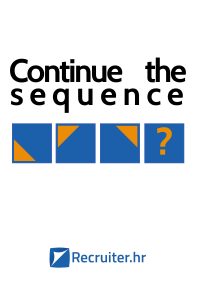
CONTINUE THE SEQUENCE
Continue the sequence is a test of abstract (fluid) intelligence, applicable in all situations where information about the level of development of general cognitive abilities can be useful. It relies on the Cattell-Horn theory, which is based on modern psychometric foundations, and it views fluid intelligence in the quick and efficient solving of mental problems and the ability to discover relationships. By designing tasks that include logical sequences, taking into account theoretical assumptions and content analysis of existing tasks intended to assess fluid intelligence, the Continue the Sequence test was defined. With some perceptual and spatial components included in the tasks, it is basically material that indicates the ability to discover relationships and laws, reasoning on non-verbal material, manipulation of content from short-term memory and speed of information processing, speed of perception and ability to rotate characters. Excellent standard psychometric indicators, established on data collected on large samples of respondents, confirm the validity and value of this digital cognitive instrument.
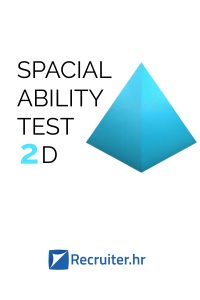
SPATIAL
When it comes to cognitive abilities in an organizational context, in addition to measures of general intelligence, individual, specific factors are often assessed. In professions, jobs and activities that require mental manipulation of objects and spatial visualization, measuring spatial abilities is often an unavoidable step in the assessment. For example, in architecture, art, drawing and design, and professions such as carpentry or dentistry, great importance is attached to the visualization of 3D characters and the mental rotation of characters in space. The “spatial” test covers precisely the ability to visualize a three-dimensional object based on the offered two-dimensional drawing. It also includes the ability to visualize the object after rotation in space. Therefore, a person’s achievement on this test indicates the level of development of their spatial abilities. People who achieve high results on this test usually have no problems with spatial orientation, they understand spatial relations and can imagine how an object would look if they were to construct it from the offered parts, that is, they can recognize a design in two-dimensional form, which would correspond to a three-dimensional object.
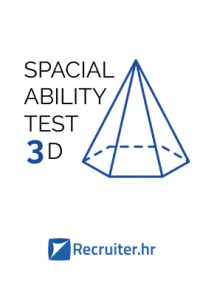
SPATIAL FACTOR
The “Spatial factor” test attaches great importance to the visualization of three-dimensional characters and their mental rotation in space. It consists of a series of tasks that require comparing two-dimensional drawings with three-dimensional characters. To successfully solve this test, it is necessary to recognize the connections between objects so that they mentally move in space. People who can easily deduce exactly what an object would look like after construction according to the proposed design achieve a high score on this test. Spatial abilities generally include information about shapes, sizes, locations, and relationships between objects. Understanding these aspects and the ability to mentally manipulate objects, or spatial abilities as such, are important for a number of professions, such as dentistry, architecture, art, drawing and design. This is precisely why the Spatial Factor test found its place in organizational processes. It represents a reliable, short, simple and high-quality instrument that captures and measures spatial abilities in a valid way.

NUMERICAL FACTOR - LOGICAL REASONING
The numerical factor test was constructed due to the need to assess numerical abilities in selection processes for positions that require handling numbers and mathematical-logical reasoning. By designing the tasks, applying them over many years and analysing the responses of a large number of people, a version was finally constructed that proved to be a homogeneous measure and represents a quality instrument in terms of psychometry. It collects important information about the development of numerical cognitive abilities of individuals in a short period of time. This kind of information is useful in selection processes and in various assessment situations, where knowing the level of logical and mathematical reasoning and handling numbers in general can be crucial. Precisely for this reason, this test is often a standard part of batteries used in the selection of candidates for, for example, accounting and bookkeeping positions.

FIND THE RIGHT WORD
“Find the right word” is an instrument intended to assess verbal comprehension, which was constructed on the basis of multiple applications and analyses of data collected on large selection samples. The test includes a series of newly designed tasks of synonyms and antonyms, checked in a large number of selection situations and psychometrically validated in the same context. Due to its high internal consistency, clear factor structure and confirmed convergent-divergent validity, it represents an adequate instrument for various assessment situations. Contributions to its criterion validity were also collected in the selection context, taking into account the candidate’s evaluations at the end of the selection process and the job interview. The significance of the “Find the right word” test can be particularly evident in selection processes for positions that emphasize verbal abilities.
TESTS FROM OUR PARTNERS
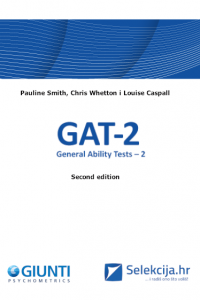
GENERAL ABILITY TESTS - 2
It is a new, improved version of well-known and standardized tests for the assessment of intelligence. GAT-2 tests include a set of five separate instruments of specific cognitive abilities, providing information on the level of development of verbal, abstract, numerical, spatial and mechanical factors. Assessment on the GAT-2 Verbal Test is based on tasks that require the use of abstract thinking and information encoding, as well as understanding the relationships and connections between pairs of words. It involves the ability to draw logical conclusions on verbal type material. The abstract (non-verbal) test captures the ability to understand relationships between elements, generalize, perceive details and predict the consequences of actions, thereby assessing logical reasoning. The numerical test uses a series of tasks to measure the ability to reason inductively and to understand numerical relationships and logical connections between numbers. The spatial test focuses on the ability to create, remember and process complex mental images and includes performing mental rotations, visualizing three-dimensional shapes and manipulating complex stimuli. Finally, the mechanical test involves understanding the way systems function, analysis of different elements of the problem and the relationship between them, and implies the application of information and mechanical principles in real situations, i.e. their use in solving practical problems. The information available after the application of these tests, in numerical and graphic form, is supplemented with interpretative comments, which indicate the implications of the achieved accomplishments and contribute to the clarity of the assessment.

CRITICAL REASONING TESTS
CRT tests come in two forms – one that measures numerical ability and one that measures verbal ability. Their use is particularly appropriate when testing cognitive potential and critical reasoning abilities within the framework of managerial profile assessments. The numerical test, for example, is significant because it provides information that can facilitate the selection of candidates for positions that involve making decisions related to resources. It seeks to measure how well a candidate is able to understand numerical information presented in the context of real situations. Basically, it assesses the level of basic cognitive capacities necessary for success in any management position. The verbal test of critical reasoning is also designed in such a way as to provide valuable input in the framework of testing highly educated personnel. This test requires the examinee to analyse and evaluate the available data and recognize implicit assumptions in the verbally presented content. It actually measures how people deal with possible business situations that require processing available information and drawing valid conclusions.
 English
English


